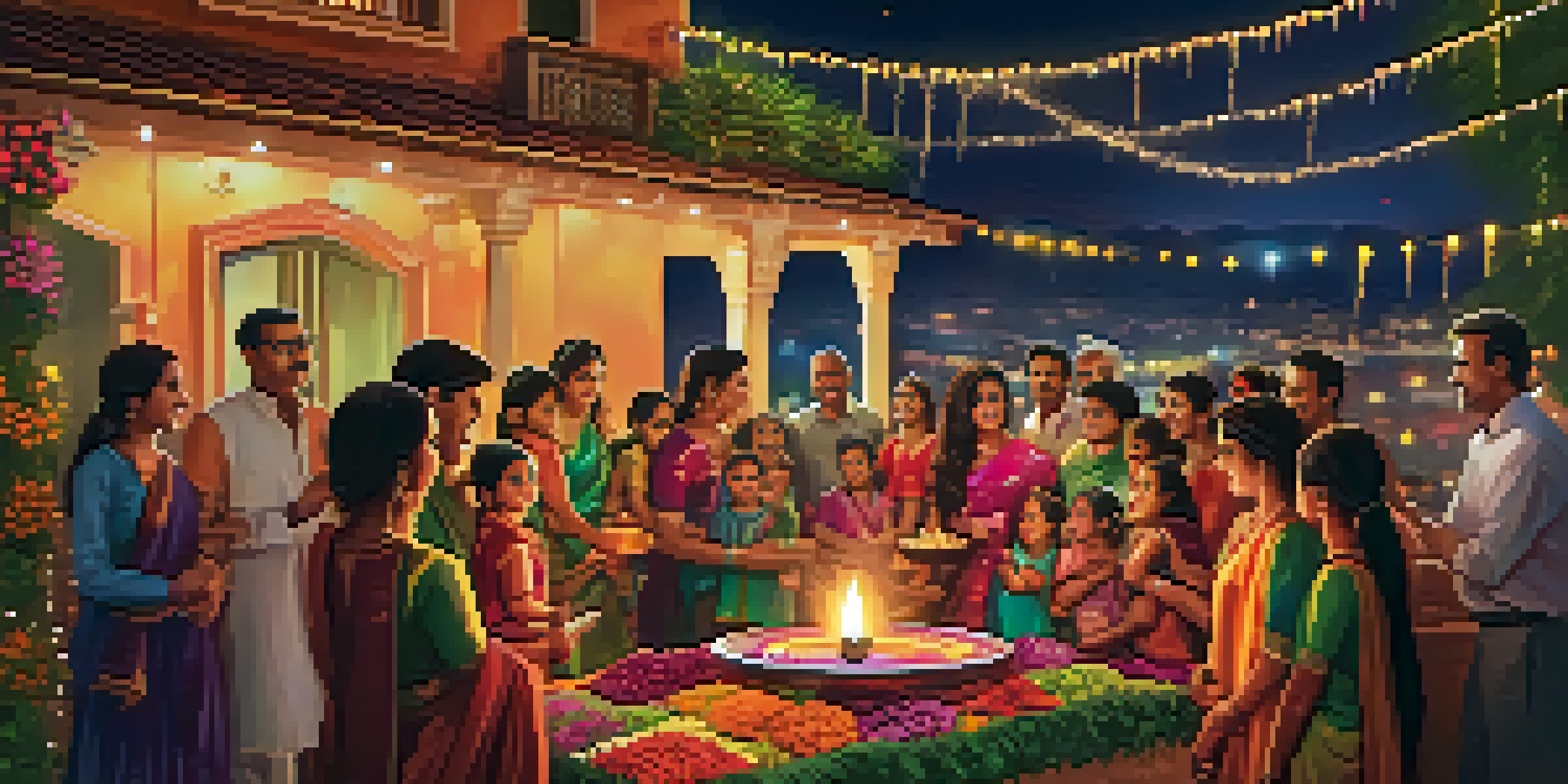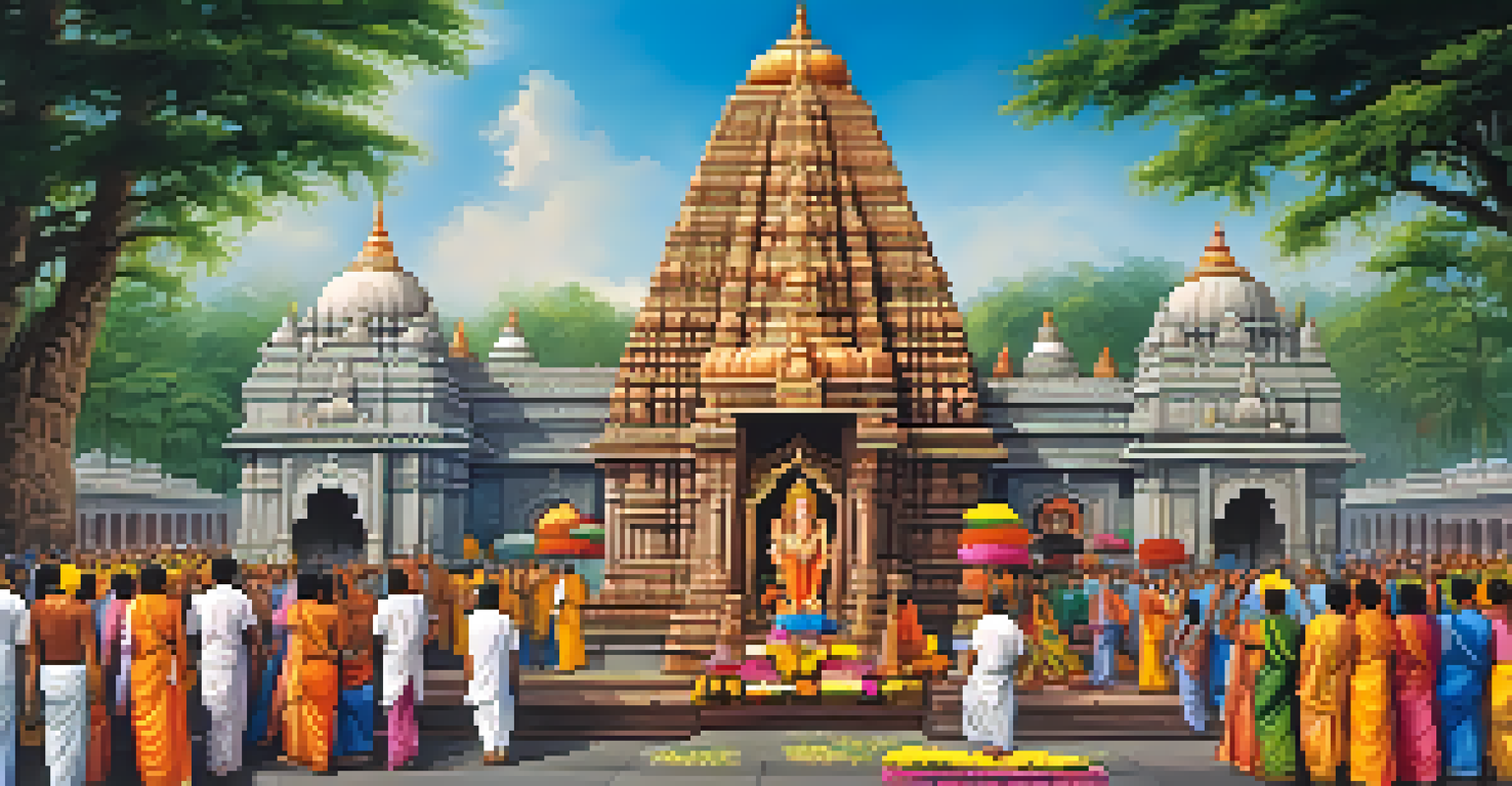Hinduism: Diverse Spiritual Expressions Across Regions

Understanding Hinduism's Core Beliefs and Values
At its heart, Hinduism is not just a religion but a way of life, deeply rooted in various texts, rituals, and philosophies. Unlike many other religions, it does not have a single founder or a uniform set of beliefs. Instead, it embraces a wide spectrum of ideas that are united by core concepts such as Dharma (duty), Karma (action and consequence), and Moksha (liberation).
Hinduism is not just a religion; it's a way of life, a philosophy that encompasses all aspects of existence.
These foundational beliefs manifest in myriad ways, influencing how individuals and communities practice their faith. For instance, the concept of Dharma encourages people to live righteously according to their roles in society, leading to diverse interpretations and practices across regions. This diversity is one of Hinduism's greatest strengths, allowing it to remain relevant through centuries.
Moreover, the idea of Karma teaches that our actions have consequences, shaping not only this life but future incarnations as well. This belief fosters a sense of responsibility and encourages ethical living. As a result, practices can vary widely, reflecting the unique cultural contexts in which Hinduism is practiced.
Regional Variations: North vs. South India
One of the most striking aspects of Hinduism is its regional diversity, particularly when comparing North and South India. In North India, for example, Hindu practices often emphasize the worship of deities like Rama and Krishna, with vibrant festivals such as Diwali and Holi celebrated with great fervor. Temples in this region often feature intricate carvings and are bustling with devotees.

Conversely, South Indian Hinduism is characterized by its own unique set of deities and festivals. Here, the worship of deities like Shiva and Murugan takes center stage, with elaborate rituals and classical music accompanying temple ceremonies. Festivals such as Pongal and Thaipusam highlight the rich agricultural traditions and local customs that shape worship in the South.
Core Beliefs Shape Hindu Practices
Fundamental concepts like Dharma, Karma, and Moksha guide diverse interpretations and practices across Hinduism.
Despite these differences, both regions share a common spiritual thread, emphasizing devotion (Bhakti) and the importance of rituals. This regional diversity not only enriches the practice of Hinduism but also showcases the adaptability and resilience of the faith across different cultural landscapes.
The Role of Festivals in Hindu Spiritual Practices
Festivals are a vibrant expression of Hindu spirituality, bringing communities together in celebration and devotion. Each festival, from Diwali to Navaratri, has its own significance and set of rituals, often reflecting the local culture and traditions. These celebrations serve as a collective reminder of the shared beliefs and values within the community.
Yoga is the journey of the self, through the self, to the self.
For instance, during Diwali, the Festival of Lights, families decorate their homes, exchange gifts, and perform prayers to Lakshmi, the goddess of wealth. This festival not only symbolizes the victory of light over darkness but also fosters a sense of unity among families and friends, reinforcing social bonds.
Similarly, Navaratri, which honors the goddess Durga, involves nine nights of dance, music, and fasting. This festival highlights the dynamic nature of worship and the communal spirit of Hinduism. Through these celebrations, devotees express their spirituality in ways that are deeply personal yet collectively meaningful.
Influence of Local Cultures on Hindu Practices
Hinduism has a remarkable ability to adapt and integrate local customs, resulting in a rich tapestry of spiritual practices. In regions like Bengal, for instance, the worship of the goddess Durga is deeply intertwined with local traditions, resulting in unique rituals and artistic expressions. The immersion of Durga idols in rivers at the end of the festival is a visually stunning example of this cultural blend.
Similarly, in the coastal regions, the worship of deities like Venkateswara often includes local elements such as seafood offerings and music styles unique to the area. These adaptations reflect the seamless way Hinduism incorporates local customs, making the faith more relatable and grounded in the lives of its followers.
Cultural Diversity Enriches Hinduism
Regional variations in worship and festivals highlight how Hinduism adapts to local cultures while maintaining core values.
This interplay between Hinduism and local cultures not only enriches the spiritual experience but also preserves cultural heritage. It showcases how Hinduism thrives within diverse environments, allowing for an ever-evolving practice that honors both tradition and local identity.
The Concept of Yoga: A Path to Spiritual Growth
Yoga is often associated with physical postures and exercises, but its roots lie deeply embedded in Hindu philosophy as a means to achieve spiritual growth. Traditionally, yoga encompasses various paths, including Bhakti (devotion), Jnana (knowledge), and Karma (action), each offering a different approach to experiencing the divine. This holistic understanding makes yoga an integral part of Hindu spiritual practice.
In many communities, yoga is practiced not just for physical health but as a spiritual discipline that cultivates mindfulness and self-awareness. For instance, practitioners may engage in meditation (Dhyana) as a way to connect with their inner selves and the broader universe, reflecting the belief in the interconnectedness of all beings.
The modern global popularity of yoga has also led to the emergence of new interpretations and practices. While some may focus primarily on the physical aspects, the original intent of yoga as a transformative spiritual journey remains at the core of its practice in many Hindu communities.
The Significance of Sacred Texts in Hinduism
Hinduism boasts a vast array of sacred texts that serve as spiritual guides, each contributing to the diverse expressions of faith. The Vedas, considered the oldest scriptures, provide foundational rituals and hymns, while the Upanishads explore philosophical concepts and spirituality. These texts set the stage for centuries of commentary and interpretation, leading to rich theological discussions.
Other important texts, such as the Bhagavad Gita, present accessible dialogues about duty, ethics, and devotion. The Gita, set in the context of a battle, offers profound insights into the nature of life and the importance of following one’s path, making it relevant to people across various walks of life.
Yoga as a Spiritual Discipline
Beyond physical exercise, yoga represents a holistic path to spiritual growth within Hindu philosophy.
These sacred texts are not merely historical documents; they are living scriptures that influence daily practices and beliefs. Recitations, teachings, and discussions around these texts foster a sense of connection to the divine and to the vast tapestry of Hinduism's literary heritage.
Hinduism's Global Influence and Modern Adaptations
In recent decades, Hinduism has transcended geographical boundaries, influencing spiritual practices globally. The rise of yoga and meditation as wellness trends reflects a growing interest in the holistic aspects of Hindu philosophy. People from diverse backgrounds are drawn to these practices, often seeking stress relief and personal growth.
Moreover, the global Indian diaspora has played a crucial role in spreading Hindu traditions and festivals worldwide. Celebrations like Diwali and Holi are now observed in many countries, showcasing the vibrant culture and spirituality of Hinduism to a broader audience. These events foster cultural exchange and create a sense of community among diverse groups.

As Hinduism continues to adapt to modern contexts, it faces both challenges and opportunities. The need to stay relevant while preserving core beliefs is a balancing act, but the resilience of Hinduism's diverse expressions ensures that it remains a dynamic and enriching spiritual path for many around the world.